Archive for Xeriscape
Irrigation 101: The Importance of a Good Sprinkler System Design
A good sprinkler system is one that satisfies your home’s landscape watering requirements, letting it flourish beautifully while saving large amounts of water and money. The benefits of investing in professional sprinkler system design are numerous:
- You no longer need to worry about watering at the proper times.
- Plants, tree, and ground covers get the right amount of water.
- Over and underwatering is virtually eliminated.
- A healthier landscape improves your home’s value.
Every sprinkler system we design is done with the xeriscape principles of promoting water conservation and reducing the need for regular maintenance in mind.
Plot and plan the perfect sprinkler system design
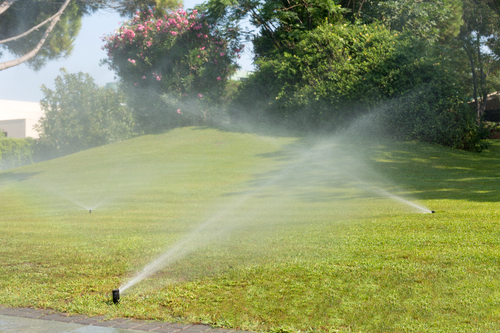
There’s a lot that goes into designing a good sprinkler system. Flow, working pressure, pipe sizing, water velocity, and friction loss must all be taken into consideration. There’s also valves, timers, and irrigation heads to think about. Add it all up, and it’s easy to see why having a pro handle it is a great idea!
Here’s a brief rundown on how a typical sprinkler system design plan comes together.
Measure and design
The first step in any sprinkler system design is measuring the property then plotting where fixed elements like your home, the driveway, paths, fences, patios, and decks are located. Next, current and future lawns, shrubs, ground covers, trees, and other plantings are added to the drawing. The landscape is then divided into areas such as front yard, back yard, side yard, shrub areas, lawn areas, and so on.
System design capacity
It’s not as complicated as it sounds. To design an automatic sprinkler system, you need to know how much water is available to irrigate your landscape. Most systems are designed to use water supplied by the city or township, but some people draw their water from wells or lakes. Determining capacity involves measuring water pressure (PSI) and water volume (GPM) then using those figures to make sure the most efficient watering system is put in place.
Product selection
Sprinkler heads and valves are two of the most important components. There two broad types of sprinkler heads:
- Rotating stream spray sprinklers that operate by rotating streams of water back and forth or in circles over the landscape.
- Small area fixed spray sprinklers that spray a fan-shaped pattern of water over a fixed radius.
Many homeowners also include a drip system in their sprinkler systems and most designs include a combination of all three types. Which ones are placed in which locations depends on water pressure, space, and area shapes like curved pathways or raised beds.
We’re sometimes asked if one system is less expensive than the other. In our experience, it tends to work out the same. Rotor heads require less pipe and trenches, but the rotors themselves cost more. Spray heads may be less expensive, but they need more pipe, trenches, and valves.
Whichever design you select, the sprinklers are then divided and placed into zones that are irrigated at different times of the day, taking into consideration things like sun exposure, plant types, and watering needs.
Create the perfect xeriscape sprinkler system
A well-designed sprinkler system design is sure to improve the health, appearance, and value of your landscape. If you’d like to learn more about our sprinkler system design services, contact us online or give us a call at 707.280.3632. Our professional team sprinkler design team is ready to give you the cost-effective, efficient, and long-term landscaping irrigation solution you’ve always wanted.
There’s More to Landscape Maintenance Than You Might Think
Landscape maintenance is all about keeping your yard and garden attractive, safe, and healthy. That means keeping the bugs, insects, and other pests away and making sure that everything is cut and trimmed to keep your home or business landscape looking wonderful.
Getting on a regular landscape maintenance schedule might even be a good idea since it means less time spent pruning and weeding and more time spent with your family.
Professional landscapers can also handle the hard stuff like topsoil enrichment and making sure your lawn is on the right irrigation schedule.
Landscape Maintenance: Where Art and Science Meet
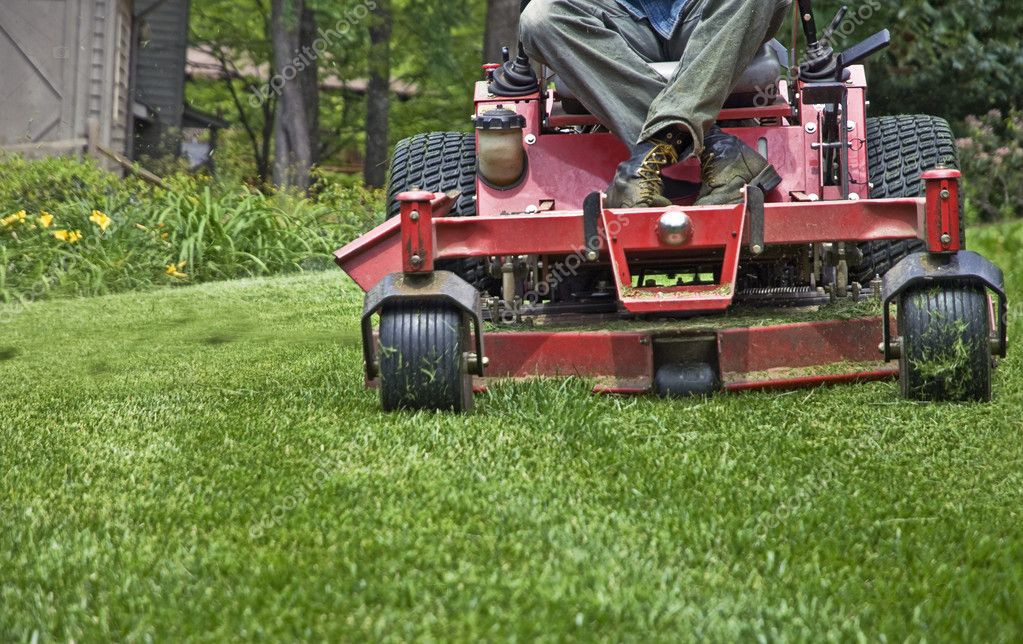
Professional landscaping is as much an art as a science. There’s a real science to, for instance, getting the pH balance of your lawn just right for growing plants, shrubs and flowers.
(Most grass likes a pH of about 7, though some warm-season grasses like more acidic soil with a pH of around 5. Don’t worry: The pros can tell you what’s right for your lawn!).
Now, one of the more scientific aspects of lawn maintenance is lawn aeration where your soil is perforated to allow in more water and the kinds of nutrients that your soil needs to perform at its best.
These tiny holes that are made when you have your lawn aerated also help get more air into the soil and help you avoid soil compaction. (That’s something you don’t want at all since soil compaction can negatively affect nutrient absorption and root growth.)
There’s as much art to landscape maintenance, though, since landscapers have to balance the layout, lighting, walkway access, and fencing of your yard with choosing and maintaining just the right bushes and mulch for your particular landscape.
Choosing the right kind of mulch – whether that’s straw, chips, stone, or bark – is important for making your garden and overall landscape look fantastic.
Mulching can also help prevent your garden from being ensnared by a bunch of weeds and ensure that soil compaction doesn’t become an issue for your lawn and garden.
The right kind of mulch can frame your landscape beautifully, promote nutrient absorption, and limit water use since more moisture gets to the roots.
Who Can Benefit from Regular Landscape Maintenance?
Because landscape maintenance covers so much ground almost any homeowner or business can reap the benefits. Condos, gated communities, shopping centers, community centers, banks, universities. You name it.
Any business that has a landscape that they want to protect and any homeowner that wants to improve their curb appeal should seriously consider getting on a regular landscape schedule.
So, do you currently need to be experiencing lawn issues to hire a landscaper? Not necessarily, but landscape maintenance includes things like fertilizing and spot treatments to address those pesky bald spots on your lawn.
Uprooting weeds is another thing that most homeowners don’t exactly look forward to doing but that can have a big payoff when it comes to keeping your lawn healthy and beautiful.
When you get on a regular landscape maintenance schedule you can have weeding, aeration, mowing and mulching taken care of.
Knowing that you’re doing the most to improve the curb appeal of your home or the attractiveness of your business property lends a huge amount of confidence that’s sure to spill over.
A professional landscaping company will even provide monthly irrigation inspections to ensure your yard, garden, shrubs, and bushes are getting the nourishment they need. You can also have your lawn pH tested to take the guesswork out of it.
Contact us to discover all of the amazing benefits of getting on a regular landscape maintenance schedule.
Learn How To Create The Perfect Xeriscape
When people say xeriscape they are referring to the practice of designing landscapes using slow-growing, drought-tolerant plants that aim to promote water conservation and reduce the need for regular maintenance.
Although recent drought conditions have created an urgency to adjust to different landscape practices like xeriscaping, many people still opt for xeriscape designs because they look amazing when finally complete.
Having said that, it’s important to remember that designing a xeriscape is not just throwing certain plants into some dirt and expecting them to look spectacular, it’s a process.
So, to help people to get a better grasp of things, we’d like to share some fundamental aspects on the best way to create the perfect xeriscape!
Accurate Designing Will Determine the Final Look
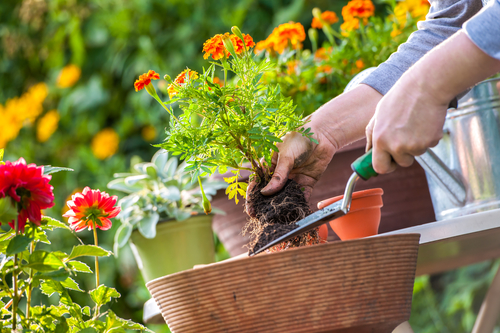
Now, to be as straightforward as possible, it’s important that people know that having plant material in the right place, is one of the most important aspects of xeriscaping.
Whether it be that you’re giving a facelift to an old landscape or designing a new one altogether, a proper design is vital – especially if you intend to conserve resources and achieve an amazing result.
Tips That Help With Xeriscape Design
- Assess the area for the presence of vegetation as this is an indication of whether plant material will grow well in that particular area.
- Arrange your xeriscape into of three different zones; a high water-use zone, a moderate water-use zone, and a low water-use zone. The high water-use zone should be very small, highly visible and watered as needed.The moderate water-use zone is usually a bit larger than the high water-use zone and is only watered when required. Now, the low water-use zone should be at least 60% of the area and only include plant types that are initially watered.
Using these straightforward tips you will be well on your way to creating a xeriscape design that’s efficient, practical, and easily maintained.
Soil Management And Soil Quality Is Important
Managing soil may probably be the part of xeriscaping that gardeners enjoy the least as it can involve a bit of hard work on their part but despite this, working with good, quality, soil while designing your xeriscape, is extremely important.
By knowing your soil’s strengths and weaknesses, you’ll know exactly what kind of amendments may be needed for healthy growth.
Nevertheless, always make sure to slope garden beds away from any buildings and plant drought-tolerant plants at the higher part of the slope.
Choosing The Right Plants
The best way to choose plants for your xeriscape would be to opt for more native plant species that may find it easier to adapt to your local environment.
It may be also smart to choose plants that have a slower growth rate that will mature with the rest of your landscape, add texture, and complement the surrounding area.
Here are a few plant choices you can use to make your xeriscape beautiful, functional and low maintenance:
- Southern Indian Azalea,
- Climbing Fig
- Creeping Juniper
- Sweet Alyssum
- Camellia
- Creeping Gardenia
- Jasmine
- Cleyera
- Indian Hawthorne
Why not let the professionals help you get started with creating the perfect xeriscape. Here at DK Landscaping, you can get the best xeriscaping services in California – Our professional team can come in and take care of all the hard work for you and all you have to do is sit back and watch you xeriscape mature and bloom.
Give us a call at (707) 280-3632 and our professional team will drop by to start the planning and preparation process. To learn more about our xeriscaping services you can also visit our website at dklandscaping.com.
Winter Plants – Part 2
During the winter season creatures prefer to hibernate and wait until nature affords them the opportunity to venture out into warmer conditions. There are no different to us humans as we seek to make our homes warm and comfortable during the dreaded winter weather. Your garden is certainly apart of your home and you should do all in your power to ensure it can handle winter’s fury and look its best. Vibrantly colored winter plants or even winter vegetables can enhance the life of a damp gloomy landscape.
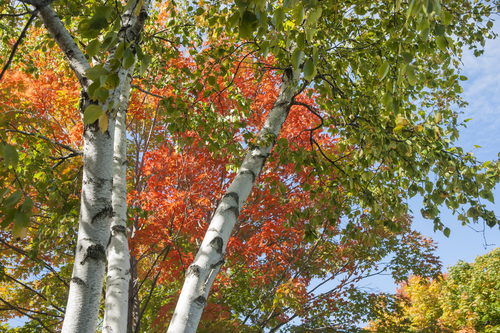
Know Your Winter Plants
An uncommon but very fascinating winter plant is Harry Lauder’s Walking Stick or Corkscrew Hazel. Even though, this shrub flowers in the spring season, it is a beautiful winter plant. This is due to its coiled and zigzagged branches. This plant tends to grow better in a fusion of bright sunlight and shade. The branches will need frequent trimming to preserve its attractive appearance however when they fall they can resemble an overgrown untidy mesh of wood.
The Paper Birch tree displays its gorgeous yellow leaves in autumn. However, when it gets extremely cold, its white bark provides a sensational difference to a backdrop of evergreens. Frequently they are used during the Christmas holidays in many gardens. The paper birch tree should be planted in deep holes with mulch to keep it damp. Partial sunlight will be essential for this plant.
The Heather plant is another suitable winter plant. It flourishes all year round and provides attractive flowers in summer and fall. It’s rich foliage provides a fascinating difference when compared to other winter plants. You should plant these in winter with mulch in an area that obtains excellent sunlight.
Holly has always been linked to winter and there are 400 assortments to select from ranging from small to gigantic trees up to 80 feet. There are various types of the holly plant to fit every garden and winter scenery. Its vibrant berries and dense foliage make it very eye-catching.
Hellebore is another winter plant that can be obtained in a fusion of selections. When flourishing it has a cup like shape and they come in an array of colors making it easy to find a color that best suits your winter garden. This plant flourishes better in total shade. Contact us for more information on how you can make create the perfect winter landscape.
Layouts and Landscaping Small Backyards
They may be diminutive in size, but small backyards can be designed and landscaped in much the same way as their larger counterparts. From a quaint cottage-style yard to a modern, minimalist look, landscaping small backyards works best when you remember to design in square inches, not feet. In addition to this also use imaginative techniques such as creating multiple focal points, and use a varied selection of plants and shrubs. While backyards with limited space present a challenge, there’s nothing to prevent you from creating a cozy and charming retreat that can also work for family entertaining. To design a truly outstanding small backyard, follow these basic design and layout principles.
Inches, Not Feet
While most landscaping is planned out by the square foot, backyards with small footprints should be designed utilizing square inches, because fitting the amenities and plants you want in a tiny space requires a very precise layout. A mere two inches can make or break your opportunity to expand a raised planter wall to seat wall width; and just a six-inch difference here or there will determine whether you can have features such as ponds, fountains or fire pits.
Use Multiple Focal Points
Probably the biggest design challenge with small backyards is the lack of space to create that one standout focal point you often find in larger backyards. The solution, then, is to create many smaller, surprising focal points throughout your yard. Stone, ceramic, glass or metal accent pieces -new or vintage – can be arranged in such a way that they create an element of delight when discovered. For a distinct look, stay away from mass-produced items and make your small backyard uniquely yours by searching for one-of-a-kind pieces of garden art. For maximum effect, place your garden art amidst your plants, so they look as though they’ve always been there.
Don’t Stop at Green
Place bold and bright plants and flowers at the front of your small landscape so that they are the first thing to catch the eye upon entering the yard. They’ll also make the rest of the backyard recede, resulting in a larger feel to the space. Use plants with lots of texture, and try putting in a few large-leaf plants – they work wonders at changing the scale of small backyards.
Create Small Discrete Zones
As counterintuitive as it may sound, dividing a small space can actually make it seem larger. Try a tall hedge, fence, wall, or shrub to create a partition. Place furniture groupings and paths so that several small attractive and restful “rooms” are created.
Xeriscape Ideas for Small Backyards
Xeriscaping is one of the most popular landscaping options today, particularly in California, as it requires a minimal amount of water. In addition to reducing the need for supplemental irrigation, drought-tolerant landscaping can also be visually more interesting than other landscape options, and it will save you money. Xeriscape landscapes require very little turf, include plants that can withstand harsh elements and embrace designs that make small backyard landscapes really stand out:
- Use stepping stones and gravel to create a path and then fill in the side areas with native grasses.
- If you have stairs up to a deck or patio, fill them with gravel and native plants to add an unexpected touch.
- Choose low maintenance greenery that will thrive in your zone and don’t forget to opt for some colorful choices – the results can be stunning.
Bringing big design to small backyards is a great way to create a space for family and friends to dine and play. So contact us for consultation. Don’t be surprised if it becomes everyone’s favorite place to gather!
Xeriscape Landscaping Ideas for Easy Gardening
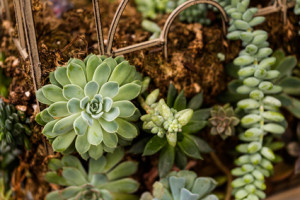 Xeriscape is a type of gardening that focuses on conserving water. You typically won’t see any lush green lawns; instead, xeriscape yards and gardens are full of local and drought-resistant plants, and typically involve creative uses of windbreaks and drip irrigation. They’re gaining popularity not just for their eco-friendliness, but because they’re very easy to maintain.
Xeriscape is a type of gardening that focuses on conserving water. You typically won’t see any lush green lawns; instead, xeriscape yards and gardens are full of local and drought-resistant plants, and typically involve creative uses of windbreaks and drip irrigation. They’re gaining popularity not just for their eco-friendliness, but because they’re very easy to maintain.
This school of gardening breaks a lot of the rules that many landscapers follow. It can be tricky to know where to get started, but here are a few ideas.
Research Xeriscape and Use Local Plants
We can’t advise you about what plants you should be using, because it’s particular to your region and your aesthetic tastes. Ideally, you want to rely as much as possible on rainfall, and the best way to do that is to use drought-resistant plants that are adapted to your area. Exotics are typically harder to maintain, and invasives often suck up water. An added benefit to choosing local plants is that local wildlife will seek your xeriscape garden out!
So head to your local library, check online, or go through a local greenhouse and ask questions of the staff there. Landscaping 101 applies here: be sure you’re choosing plants that will thrive in your soil’s pH, and with the different amount of sunshine your xeriscape gets. Remember to choose a variety of colors, and try to choose plants that will bloom over the course of the year rather than all at once.
Compost Before You Plant
After your plants are in the ground, it can be tricky to compost your xeriscape. Instead, add the compost while you’re prepping the soil for your plants. This doesn’t just make the soil richer — it also helps it retain moisture.
Permeable Paving
Asphalt, tile, or other paving surfaces catch water and cause it to puddle and eventually evaporate, where it’s lost. This “hardscaping” can also become very hot in the sun, which affects moisture absorbtion and can make your plants wilt. Using gravel, sand, or a comparable paving material on your paths lets water seep down into the soil to water your xeriscape plants.
Grade on a Curve!
Try adding a slight grade, or even terracing, to your xeriscape garden. Remember, it doesn’t help if the water puddles, or runs out to the street. You want the water to flow gently downhill, so that it trickles over the surface of the soil and is absorbed.
Use Mulch
Mulch heavily around your plants! Three to four inches is enough to keep the soil’s moisture in, and as the mulch’s bottom layers degrade they fertilize the soil. While gravel is another xeriscape option and it works great, some people find that it makes their gardens look drier and more like a desert, compared to how mulch looks.
Rainwater Harvesting and Clever Irrigation
Even with clever xeriscape techniques, you will still need to water your garden. This is particularly important for plants that are young or just getting settled, because they’re still building their root systems. Collect water to irrigate by hooking a rainwater barrel up to your gutter. Make sure you water during the cooler evening hours, and try using a soaker hose or an automated drip irrigation system. These saturate the soil, so as little as possible is lost.
Go Native, Save Water: Xeriscape Gardening
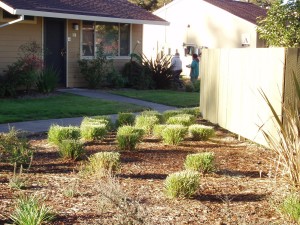 The information age has brought with it a flood a varying techniques in the fields of landscaping, gardening and ecological design. In keeping with the sustainable nature of the best of them, xeriscape gardening is defined by its optimal use of a minimal amount of water. This approach to gardening has been developed in the arid regions in the world, chiefly in the American mid-west, as a natural response to the climate. Xeriscape is most effective when the need for supplemental irrigation is eliminated and the design of the garden promotes symbiotic relationships that provide benefits. Environmental conservancy is xeriscape gardening’s top priority, but aesthetic design has received as much consideration. At its best, xeriscape becomes a melding of both utility and beauty.
The information age has brought with it a flood a varying techniques in the fields of landscaping, gardening and ecological design. In keeping with the sustainable nature of the best of them, xeriscape gardening is defined by its optimal use of a minimal amount of water. This approach to gardening has been developed in the arid regions in the world, chiefly in the American mid-west, as a natural response to the climate. Xeriscape is most effective when the need for supplemental irrigation is eliminated and the design of the garden promotes symbiotic relationships that provide benefits. Environmental conservancy is xeriscape gardening’s top priority, but aesthetic design has received as much consideration. At its best, xeriscape becomes a melding of both utility and beauty.
The Principles of Xeriscape
As conceived by Denver Water, xeriscape gardening’s most revered proponent, these seven guiding principles provide the foundation for all considerations within the field. Each principle holds an entire discipline within itself, which means that there is always more to learn and improve upon in this field.
- Planning and Design are the cornerstones of effective gardening, which requires careful attention to your specific environment.
- Soil Management is about knowing what nutrients your selected plants need and what nutrients are available in the soil. Composting is a great way to reinvigorate malnourished soil.
- Plant Selection is an integral part of xeriscape gardening. Thousands of species exist in arid conditions, each with benefits and beauty to offer.
- Turf Minimalism is crucial because the water needs of most grass lawns makes them impractical for dry climates.
- Diligent Irrigation may be the reason you’re interested in xeriscape gardening to begin with. Water is an invaluable resource and appropriate use of it is essential to environmental conservancy.
- Mulch can be composed of several materials such as leaves, wood chips, pine needles and bark. It is spread over the surface of the soil to help with water retention, fertility, prevention of erosion, and reduction of weed growth.
- Maintenance in the form of weed pulling, mulching, and general upkeep should be combined with constant observation to check if your garden layout is working to its full potential.
The Benefits of Xeriscape
- Reduced Water Consumption is both the key aspect of xeriscape gardening and a great benefit of it. It means using less water and making better use of it. Not only will this save you money, but you will be helping your community and environment as well. Re-appropriating rainwater can help you prevent evaporation and runoff, and your garden’s layout can be optimized for better use of it.
- Less Maintenance is required from a xeriscape garden. Much less fertilizer is used, which helps urban runoff pollution, lawn mowing becomes nigh unnecessary, and simple irrigation systems can handle all of your watering needs.
- Pest Control is an added benefit of a really well thought out garden layout. Certain xeriscape friendly plants ward off insects, while prickly cacti do the same for intrusive mammals. Plant selection also enables you to create a sanctuary for desirable birds and insects.
- Property Values Rise when you drought-proof the terrain around your home. Likewise, the design opportunities available to xeriscape can make for some exquisite gardens.
There are an abundance of tips and tricks available for do-it-yourself xeriscape gardening, but expert consideration reaps the true benefits of the art form. Xeriscape specialists develop an uncanny ability to read an environment and discern its possibilities. With a little help, and dedication to the sustainability principles of xeriscape you could be looking at a lower water and power bill, a productive and efficient garden, and a beautiful area in which to relax.
10 Ways to Save Water in Your Yard
 As a homeowner or business owner, it may seem impossible to keep your yard attractive and thriving while trying to save water. Whether your region is going through a drought, city water prices are through the roof, or your area is implementing bans on watering yards, learning how to save water is becoming essential.
As a homeowner or business owner, it may seem impossible to keep your yard attractive and thriving while trying to save water. Whether your region is going through a drought, city water prices are through the roof, or your area is implementing bans on watering yards, learning how to save water is becoming essential.
Here are 10 ways you can save water in your own yard:
1. Implement Xeriscape Landscaping
For decades, xeriscape has been practiced by the landscaping industry. This concept allows you to have a livable outdoor space that doesn’t require major amounts of water. While xeriscapes still need to be regularly maintained, their smart designs save water, as well as your time and major backaches in the long run.
But don’t try to implement the principles of xeriscape alone. Your local landscaping company will be your best resource for establishing one. According to LandscapeNetwork.com, “For anyone contemplating a xeriscape, selecting an experienced designer is vital to success… The skill set in demand is a firm knowledge of both local native species used for landscaping, plus the array of imported species from dry climates around the world that expand our options considerably. There is no better way to make your home environmentally green and create a model landscape for water conservation.”
2. Plant Native Plants or Drought-Resistant Plants
Use native plants in your yard to save water. These plants are acclimated to your climate and are used to your region’s rainfall. Drought-resistant plants like daylilies contribute bright, cheery colors to your yard’s design without hogging water.
3. Use Mulch
Mulch such as wood chips or lava rock (not black plastic) is handy at preventing weeds. However, it also keeps moisture in the soil. It shades soil so that the soil’s temperature doesn’t heat up, translating to water savings.
4. Adjust Sprinkler Irrigation Systems
If you use sprinklers but they’re not adjusted properly, they won’t save water. Mist settings may cause water to blow in the wind or evaporate before it reaches your thirsty yard. Settings with larger droplets ensure that the water is reaching your plants. Make sure sprinklers are pointed to your lawn and not spurting water wastefully at sidewalks.
5. Yard Watering
The time of day that you water plants is important. Plan on watering around cooler times of the day like dusk or dawn. This will ensure that you save water since the water isn’t merely evaporating before it hits the ground. Don’t water when it’s windy.
6. Harvest Rain Water
Rainwater harvesting means you accumulate and deposit rainwater on-site so it doesn’t merely create run-off. For example, rain barrels can capture rain coming off your roof. You can save water and money simultaneously!
7. Mow the Grass
If you mow your grass too much, you could be contributing to water waste. Keep your main lawn around 3 inches tall so the soil retains water but water isn’t merely soaked up by tall grass (which can also harbor pests).
8. Pay Attention to Fertilization Times
Don’t fertilize your lawns during hot, dry weather. This could exacerbate current drought problems. Use a slow-release fertilizer to save water.
9. Create Decks and Paths
Add patio stones, gravel paths, and decks to decrease the amount of area in your yard that needs to be watered. Your landscaping company will have ideas on how these items will look great in your yard but contribute to a functional design too.
10. Form Ditches and Basins
Form ditches and basins around your plants. This practice will keep a well of water near your plants’ roots.
Xeriscape Landscaping in Sonoma County
 Xeriscape Why?
Xeriscape Why?
Xeriscape became a word invented by Denver Water Department when forbidding watering in summer. Sonoma residents must:
- select plants appropriate to your climate,
- mulch plants to help them retain moisture
- care for your plants properly
- keep plants healthy
- Plant shrubs, trees and other attractive plants where grass used to be.
The foregoing basics reduce water consumption 60 percent. Instead of a monotonous expanse of lawn in shades of green to brown, your yard can become rich with variety and interesting to observers. Filling your yard with a variety of hardy drought tolerant plants indigenous to your area is making a pact with Mother Nature that you are on her side. You are now going to help her with a bounty of beautiful plants she worked over 1,000 years to perfect for your exact piece of land.
Prepare the Yard Soil
- Pick up a fistful of thoroughly wet soil from your yard and squeeze it into a ball. The ball will stay formed or will crumble apart.
- Add organic material to your soil if the ball of dirt crumbled quickly. Compost or manure helps crumbly soil retain moisture.
- Add sand or ground bark to the soil if the ball of dirt formed a tight, hard ball. Hard, clay soil allows all water to run off quickly before it even has a chance to reach a plant’s roots.
Grow Plants Nature Designed for Sonoma
- Grow plants native to the Sonoma parched earth. They adapted mechanisms over hundreds of years to tolerate and cope with your weather and water gauge, so require little watering. Landscape companies can recommend plants for you so that your unique taste can still be displayed in your xeriscape garden.
- Plant trees suited to dry landscaping, such as California buckeye, which though their seeds are poisonous, make great shaped trees. The U.S. Department of Agriculture plant hardiness dictates zones 6a and higher for Sonoma.
- Plant drought-tolerant xeriscape shrubs like California wild lilac, best in USDA zones 5b or higher with lovely flowers. California wild lilac can grow in either full sun or partial shade.
- Choose drought-tolerant ornamental grass like blue lyme for full sun or light shade. This clumping grass is very hardy, with gray-blue foliage and grows up to 4 feet tall with very little water.
- Plant xeriscape succulents in your hard that will store water in fleshy leaves and need little water from you. The Century plant, or Agave Americana, grows well in USDA Zones 9a through 11 in full raging sun or a little shade. Reaching 8 feet in height and 12 feet wide. They provide a focal point if you just make sure you have a safe distance between its spiny leaves and foot traffic.
Follow Xeriscape Principles
- You must cover your entire garden with a layer of mulch or compost so that the need for moisture due to evaporation is nil. Compost has nitrogen, giving plants nutrition and improving texture of your xeriscape yard soil.
- Water in early morning or evening to minimize any evaporation. Drip irrigation systems are the most effective method for Sonoma.
List of Zero to Low Water Need Plants for Sonoma Area
There are many drought tolerant plants needing no supplemental summer water once established. While these are uber-drought tolerant xeriscape plants, some will do a bit better with some water. Some fine shrubs that meet these criteria are:
- Arbutus Onedo
- Acca Sellowiana
- Baccharis Pilularis
- Buxus
- Callistemon spp.
Contact your local landscape company to learn the multitude of xeriscape plants that can beautify your home without watering!






